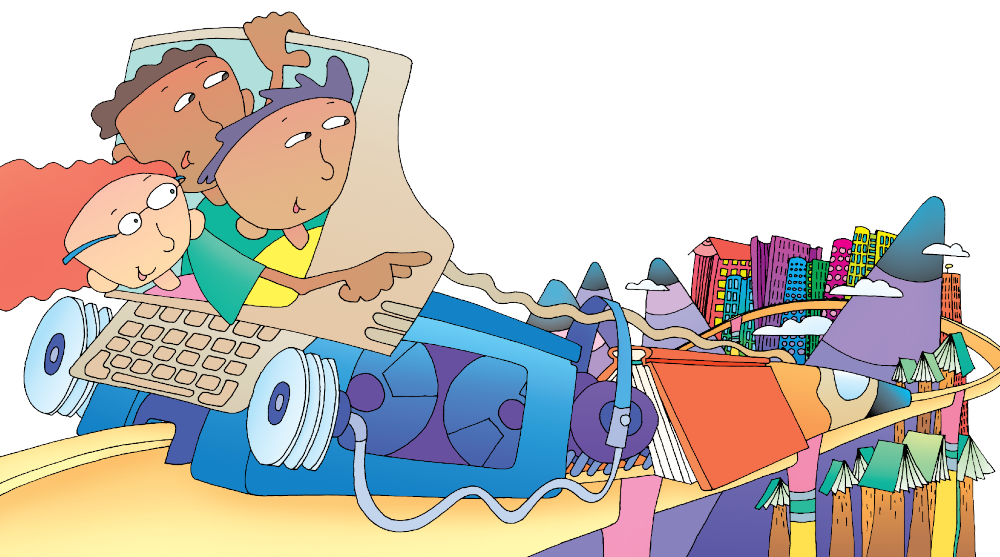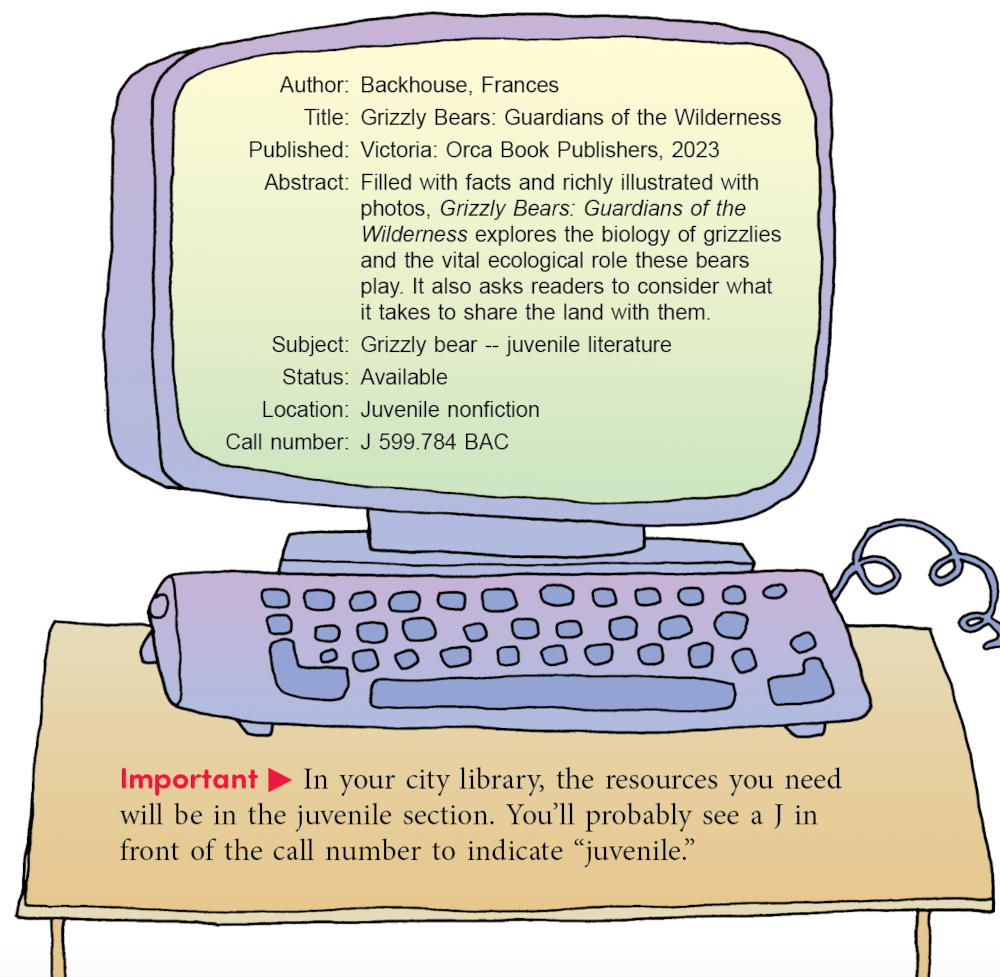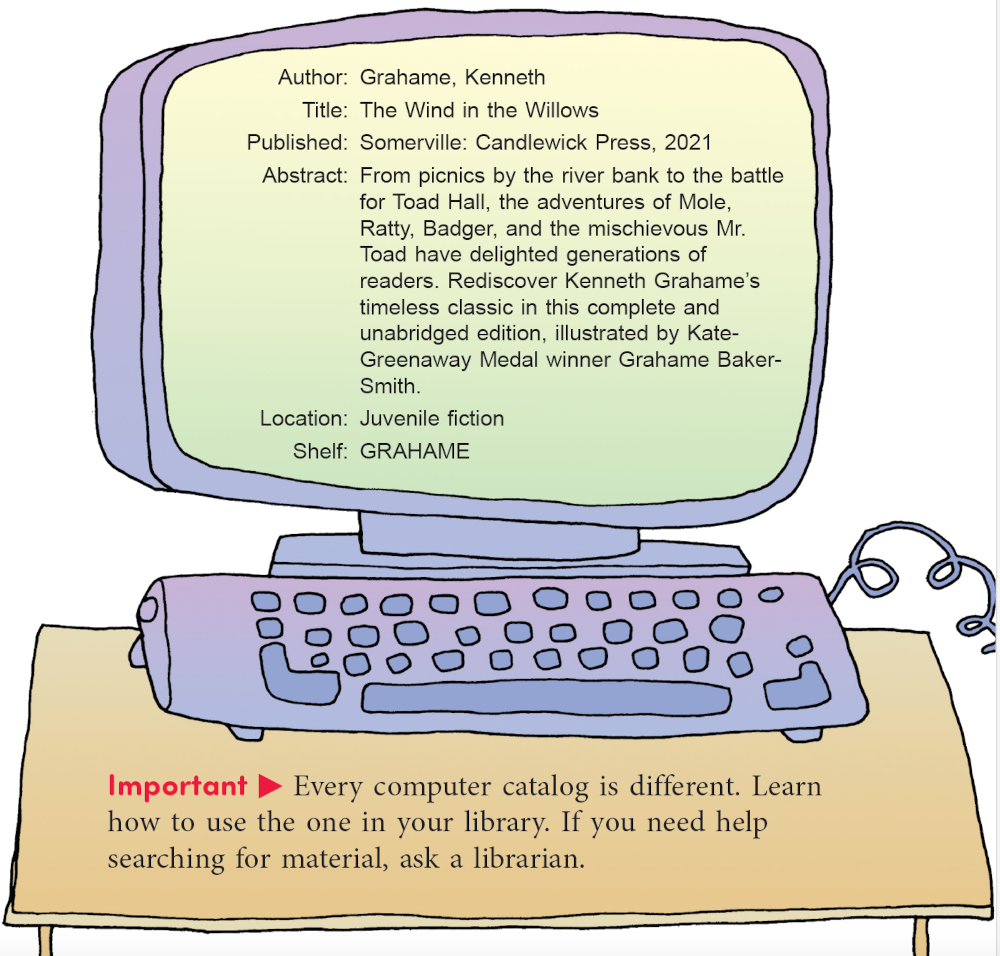WT 197
Page 197
Using the Library
Your school or city library is your portal to information. In person, you’ll find books, magazines, newspapers, videos, and music. Online, you’ll find a database of encyclopedia articles, ebooks, dictionaries, atlases, and much more. Libraries aren’t just for reports. They help you explore any topic you care about!
Finding Your Way
This chapter explains how libraries are organized and how you can find information. Best of all, your library has friendly librarians who know their way around the resources and can help you find exactly what you need.

WT 198
Page 198
Searching the Computer Catalog
The computer catalog lists materials in your library and others in your system. After reading the directions on the screen, you can search for information in three main ways:
1. Title Search: If you know all or part of the title you need, enter it in the search box. Keywords are more important than words like a, an, or the.

2. Author Search: If you know the name of the author, enter it. Make sure you spell the person’s name correctly.

3. Subject Search: If you don’t have specific materials in mind, type in the topic that you have chosen. Once again, keywords are most important.

Viewing Search Results
When you press “Enter,” you will see a list of materials. Click on the title that interests you. Then you will see key information about the material. Look for these details:
🟪 Status tells if the resource is available or checked out.
🟪 Location tells you which part of the library has the material, or which library in your system has it.
🟪 Call number helps you find the material, so write it down. (See page 201 for more about call numbers.)
WT 199
Page 199
Sample Nonfiction Search Result
Any of the searches on page 198 would lead to the following book entry. Note author, location, and call number.

WT 200
Page 200
Sample Fiction Search Result
You can also find fiction books in your computer catalog. Novels are shelved alphabetically by author’s last name.

WT 201
Page 201
Finding a Book
Once you’ve gotten search results for a book, write down the call number. The call number helps you find a book on the shelves.
Finding Nonfiction
Nonfiction (factual) books are arranged on the shelves in number order. Here are some things you need to know:
🟪 Some call numbers have one or more letters at the end. The book with the call number 973A comes before 973B on the shelf.
🟪 Some call numbers have decimals, like 973.19, which comes before 973.2. These books may be harder to find. Ask the librarian for help if you need it.
Finding Fiction
Fiction books are arranged together on special shelves.
🟪 Fiction books are in ABC order by the author’s last name.
🟪 Some fiction books have the first two letters of the author’s last name on the spine, like CL for Beverly Cleary.
Finding Biographies
Biographies have their own shelves, too.
🟪 Biographies are arranged by the call number 921 and the first letters of the subject’s last name. A biography about Abe Lincoln would be 921 LIN.
-
🟪 Some call numbers have one or more letters at the end. The book with the call number 973A comes before 973B on the shelf.
🟪 Some call numbers have decimals, like 973.19, which comes before 973.2. These books may be harder to find. Ask the librarian for help if you need it.
-
🟪 Fiction books are in ABC order by the author’s last name.
🟪 Some fiction books have the first two letters of the author’s last name on the spine, like CL for Beverly Cleary.
-
🟪 Biographies are arranged by the call number 921 and the first letters of the subject’s last name. A biography about Abe Lincoln would be 921 LIN.
WT 202
Page 202
Using a Library Database
A database is a collection of information that your library subscribes to and makes available to you online.
Finding the Database
Go to your library’s website and click on the “Resources” tab. It will take you to a number of resources, including a database with a name like “BadgerLink.” Click on it to access many resources like these:
Britannica School Elementary and Explora for Elementary Schools are online encyclopedias of articles, images, maps, and games. Read about everything from aardvarks to zoology. You can even double-click words for definitions, pronunciations, and Spanish translations.
Britannica Escolar is a Spanish-language version of Britannica School Elementary.
NoveList K–8 is a fiction recommendation resource that contains all your favorite books and helps you find similar titles at your reading level. You can also use discussion guides and reading lists.
Primary Search offers access to nearly 100 full-text popular children’s magazines on a variety of topics including endangered species, musicians, fitness, and space exploration. It also includes access to encyclopedia articles and dictionary entries.
Britannica Escolar is a Spanish-language version of Britannica School Elementary.
NoveList K–8 is a fiction recommendation resource that contains all your favorite books and helps you find similar titles at your reading level. You can also use discussion guides and reading lists.
Primary Search offers access to nearly 100 full-text popular children’s magazines on a variety of topics including endangered species, musicians, fitness, and space exploration. It also includes access to encyclopedia articles and dictionary entries.
Tip
Turn to page 207 to find out more about online encyclopedias.
WT 203
Page 203
Understanding the Parts of a Book
Books are easier to use when you understand their parts. All books have some of the following parts:
🟪 The title page is usually the first page with printing on it. It gives the title of the book, the author’s name, the publisher’s name, and the city where the book was published.
🟪 The copyright page comes next. It gives the year the book was published. This can be important. An old book may have information that is no longer correct.
🟪 The table of contents tells the names and page numbers of the chapters and sections in the book.
🟪 The chapter and section headings tell what type of information is covered in each part of a book.
🟪 The captions give important information about photographs, illustrations, or graphics. They are located near the pictures.
🟪 The glossary explains special words used in the book. It’s like a mini-dictionary. Usually the glossary is near the back of a book.
🟪 The index is an ABC list of all the topics in the book. It also gives the page number where each topic is covered. The index is at the very back of the book.
🟪 The copyright page comes next. It gives the year the book was published. This can be important. An old book may have information that is no longer correct. 🟪 The table of contents tells the names and page numbers of the chapters and sections in the book.
🟪 The chapter and section headings tell what type of information is covered in each part of a book.
🟪 The captions give important information about photographs, illustrations, or graphics. They are located near the pictures.
🟪 The glossary explains special words used in the book. It’s like a mini-dictionary. Usually the glossary is near the back of a book.
🟪 The index is an ABC list of all the topics in the book. It also gives the page number where each topic is covered. The index is at the very back of the book.
(You can work with these book parts by completing this activity.)
